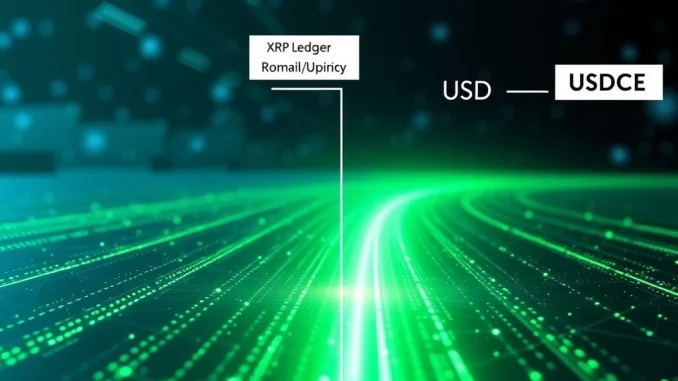
In the rapidly evolving landscape of digital finance, stablecoins have become indispensable tools for bridging traditional currencies with the crypto world. For years, tokens like USDC have held significant sway, serving as a reliable medium for transactions. However, a powerful contender built on the robust XRP Ledger is now emerging, poised to redefine the benchmarks for efficiency and compliance, particularly for institutional players. This isn’t just about faster transactions; it’s about a fundamental shift in how large-scale, compliant value transfers can occur globally.
The Unmatched Architectural Advantage of the XRP Ledger
At the heart of this paradigm shift is the XRP Ledger (XRPL) itself. Unlike many stablecoins that operate across a multitude of external blockchains, often relying on third-party infrastructures, Ripple’s RLUSD stablecoin is natively built directly on the XRPL. This foundational difference provides a significant architectural advantage. Consider the distinction:
- Native Integration: RLUSD is an intrinsic part of the XRP Ledger ecosystem. This means Ripple controls both the underlying ledger technology and the stablecoin itself, fostering a vertically integrated infrastructure.
- Eliminated Dependencies: For institutions, this integrated design simplifies operations. It removes the need to navigate complex relationships with multiple external blockchain providers, streamlining the entire value transfer process.
- Unified Control: By consolidating these components, Ripple offers an end-to-end solution that minimizes external points of failure and enhances overall system reliability. This contrasts sharply with stablecoins like USDC, which, despite their broad reach, must adapt to the inherent characteristics and limitations of each blockchain they deploy on, including varying fees and speeds.
This streamlined architecture translates directly into tangible benefits, particularly for high-volume, time-sensitive institutional transactions.
RLUSD: The Efficiency Champion in Digital Payments
When it comes to transaction efficiency, RLUSD stands out as a clear leader, especially when compared to its counterparts on less optimized networks. The XRP Ledger’s design prioritizes speed and cost-effectiveness, making it an ideal choice for the demands of modern finance.
- Blazing Fast Settlements: Transactions on the XRP Ledger, including those involving RLUSD, are processed in an astonishing three to five seconds. This near-instant finality is crucial for businesses that require rapid settlement across borders.
- Fractional Costs: The cost of executing a transaction on the XRPL is less than a fraction of a cent. This predictability and minimal expense offer significant savings compared to the often high and variable gas fees associated with Ethereum-based stablecoin transfers.
- Deflationary Tokenomics: The XRPL’s native token, XRP, has a deflationary mechanism where a small amount is burned with each transaction, further contributing to the network’s efficiency and long-term economic stability.
These performance metrics are not merely theoretical; they represent a practical solution to persistent inefficiencies in institutional financial infrastructure, offering a compelling alternative to existing stablecoin frameworks.
Outpacing USDC: A Direct Comparison for Institutional Use
While Circle’s USDC has expanded its reach, including a recent launch on the XRP Ledger, an in-depth analysis reveals that RLUSD offers inherent advantages, particularly for institutional applications. The core distinction lies in their operational models and underlying infrastructure.
RLUSD vs. USDC: Key Differentiators
| Feature | RLUSD on XRP Ledger | USDC (primarily Ethereum) |
|---|---|---|
| Native Integration | Natively built on XRP Ledger, unified ecosystem | Operates across multiple external blockchains (e.g., Ethereum, Solana, XRPL) |
| Transaction Speed | 3-5 seconds | Varies, often minutes on Ethereum (depending on network congestion) |
| Transaction Cost | Less than a fraction of a cent | Higher, variable fees (gas fees on Ethereum) |
| Control & Infrastructure | Ripple controls ledger and stablecoin (vertically integrated) | Relies on third-party blockchain infrastructure and external partnerships |
| Regulatory Posture | Evaluated for high compliance (e.g., Anchorage Digital report), aligned with institutional risk management | Faces structural risks due to insufficient buffers against market volatility |
This comparison underscores why RLUSD, with its unified blockchain and stablecoin ecosystem, presents a more streamlined and efficient approach. While USDC’s presence on XRPL validates the ledger’s technical capabilities, it inadvertently highlights the inherent benefits of a truly integrated solution.
Revolutionizing Cross-Border Payments with XRPL and RLUSD
The global demand for efficient cross-border payments continues to grow, yet the traditional financial system often struggles with high costs, slow settlements, and opaque processes. The XRP Ledger, powered by RLUSD, directly addresses these pain points, offering a transformative solution for businesses and financial institutions.
- Cost Reduction: By significantly lowering transaction fees, XRPL makes micro-transactions and frequent international transfers economically viable.
- Speed and Certainty: The rapid settlement times eliminate the delays common in traditional banking, providing greater certainty and liquidity for global operations.
- Interoperability: The XRPL’s design inherently supports multi-chain environments, enhancing its utility in a diverse digital asset landscape and addressing critical inefficiencies in global financial infrastructure.
This combination of speed, cost-effectiveness, and native integration positions the XRP Ledger as a formidable infrastructure for the future of global value transfer, offering a clear upgrade over legacy systems and even many existing blockchain solutions.
Paving the Way for Institutional Adoption with Compliance
For financial institutions, compliance and risk management are paramount. The analysis by Anchorage Digital, which evaluates RLUSD alongside high-compliance assets like PYUSD and USDP, highlights its strong alignment with institutional risk management standards. This focus on regulatory oversight and reserve composition adds a critical layer of differentiation that fosters greater confidence for institutional adoption.
- Robust Reserves: Unlike some stablecoins that face structural risks due to insufficient buffers against market volatility, RLUSD’s design emphasizes stability and transparency in its reserve composition.
- Regulatory Alignment: Ripple’s proactive approach to regulatory engagement and its vertically integrated infrastructure offer institutions a more secure and predictable environment for deploying digital assets.
- Enterprise-Grade Solution: These factors collectively position RLUSD and the XRP Ledger as a more secure and reliable option for enterprises navigating complex and evolving regulatory landscapes, making them attractive for large-scale financial operations.
By addressing persistent misconceptions about stablecoins versus native assets and focusing on an end-to-end solution, Ripple’s approach challenges the dominance of third-party solutions, making a strong case for the XRP Ledger as the preferred infrastructure for the next generation of institutional finance.
Conclusion: A New Era for Institutional Digital Payments
The emergence of RLUSD on the XRP Ledger marks a pivotal moment in the evolution of stablecoins and institutional digital payments. With its unparalleled architectural integration, superior transaction efficiency, robust regulatory alignment, and seamless multi-chain interoperability, RLUSD presents a compelling alternative to established players like USDC. Ripple’s vertically integrated infrastructure offers a holistic solution that directly addresses the core demands of enterprises seeking reliability, compliance, and cost-effectiveness in their global financial operations. As the demand for secure and efficient cross-border payments continues to surge, the XRP Ledger’s infrastructure, powered by RLUSD, is increasingly poised to attract a significant share of institutional users, solidifying its position as a foundational layer for the future of finance.
Frequently Asked Questions (FAQs)
What is RLUSD and how is it different from other stablecoins?
RLUSD is a stablecoin natively built on Ripple’s XRP Ledger (XRPL). Its key differentiator is its vertical integration with the XRPL, meaning Ripple controls both the ledger and the stablecoin. This contrasts with many other stablecoins, like USDC, which operate across multiple third-party blockchains, incurring varying fees and speeds dependent on those networks.
How does the XRP Ledger’s efficiency compare to Ethereum for stablecoin transactions?
The XRP Ledger processes transactions in 3-5 seconds at a cost of less than a fraction of a cent. In contrast, Ethereum-based stablecoin transactions often incur higher and variable gas fees, and settlement times can range from minutes to longer, depending on network congestion. This makes XRPL significantly faster and more cost-effective for high-volume transactions.
What are the primary benefits for institutions considering RLUSD on the XRP Ledger?
Institutions benefit from RLUSD’s superior transaction efficiency (speed and low cost), enhanced regulatory alignment and robust reserve composition, and the streamlined operations offered by Ripple’s vertically integrated infrastructure. This combination provides a more secure, compliant, and cost-effective solution for cross-border payments and other enterprise applications.
Does Circle’s launch of USDC on XRPL diminish RLUSD’s advantages?
While Circle’s decision to launch USDC on the XRPL validates the ledger’s technical capabilities and growing adoption, it inadvertently highlights the unique advantages of RLUSD. RLUSD’s native integration and Ripple’s end-to-end control offer a more unified and streamlined solution, whereas USDC on XRPL still relies on Circle as a third-party issuer.
How does RLUSD address regulatory concerns for institutional users?
RLUSD is designed with institutional risk management standards in mind, aligning with high-compliance assets as noted by reports from firms like Anchorage Digital. Its reserve composition and Ripple’s regulatory engagement provide a more secure and predictable environment, contrasting with structural risks faced by some other stablecoins due to insufficient buffers against market volatility.
What role does the XRP Ledger play in the future of cross-border payments?
The XRP Ledger, with its high transaction throughput, low fees, and rapid settlement times, is positioned to revolutionize cross-border payments by addressing the inefficiencies of traditional systems. Its interoperability features and the growing ecosystem around stablecoins like RLUSD make it a strong contender for facilitating fast, cheap, and compliant global value transfers for both institutions and individuals.



